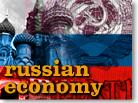|
Russia lets ruble fall
|
 |
August 17, 1998: 7:27 a.m. ET
Yeltsin sets new floating exchange rate, restructures T-bill market
|
NEW YORK (CNNfn) - Bond and currency markets were rocked early Monday after Russia made a surprise announcement that it would float its beleaguered ruble.
In a move designed to stabilize the Russian currency rate and banking system, President Boris Yeltsin on Monday announced a new plan to restructure its debt and set a new floating exchange rate that will allow the currency to fall by up to 50 percent.
Blaming the "deepening crisis in Asia and a new collapse of world oil prices" for creating a crisis of confidence in Russian securities, Yeltsin said the Central Bank also will restructure its Treasury bill market and placed a 90-day moratorium on the repayment of international debt.
"The shrinkage of the country's foreign currency reserves continues and the banking system has started experiencing certain difficulties," he said. "In these circumstances the government and the Bank of Russia consider it necessary to undertake a series of measures aimed at normalizing financial and budgetary policy."
The news sent skittish investors flocking to the safe haven of the bond markets.
U.S. Treasuries soared in London sending the 30-year bond to a record low of 5.51 percent.
The long bond was at 99-25/32, up 15/32 from Friday's close. It closed in Tokyo at 99-28/32.
September future treasury bonds were at 124-17/32, up 9/32 in automated trade.
At the same time, S&P 500 futures contracts trading on the Globex were down more than 8 points, indicating a negative drop for the Dow of roughly 60 points.
The dollar rose above 1.81 marks shortly after the news broke, but later retreated on profit-taking. By mid morning the dollar was quoted below 1.8 marks.
William Cheney, chief economist for John Hancock Financial Services, said the impact of Russia's free floating currency on the U.S. economy will be more psychological than "real."
Nonetheless, he said, it's likely to affect interest rate discussions at the Federal Reserve.
"When [the Fed] makes a move they clearly worry about these psychological factors," Cheney said. "And clearly to the extent they were worried at their last meeting, they will worry even more this time about what [an interest rate hike] would do to world markets."
Starting Monday, the Bank of Russia will implement a temporary floating ruble rate within the new "currency corridor" limits which are set at a level of between six and 9.5 rubles per U.S. dollar. The floating rate is tentatively scheduled to expire at the end of the year.
Before Monday the ruble was trading at about 6.2 to the dollar.
Under the plan the Central Bank will use interest rate policy to smooth sharp ruble rate fluctuations.
The plan, however, did little Monday to win back investor support in Russian securities.
Russia's top RTS1-Interfax index was down 3.43 percent at 111.06 after 15 minutes of trade.
Trade on the Russian Trading System (RTS), the main electronic trading system, had earlier been suspended as no rate for the ruble had been fixed on the interbank market following the announcement of the new measures.
To revive the financial market, the government will start issuing short-term securities with a maturity of one and two weeks. The spectrum of securities meant for the population will be widened.
The Bank of Russia also said it will invite stable Russian banks and leading overseas banks to participate in the effort.
"It's tantamount to devaluation," said Donaldson Lufkin & Jenrette chief emerging markets economist Charles Blitzer. "We'll have to see whether the authorities can keep the devaluation controlled or not." 
|
|
|
|
|
|
The Russian Exchange
|
Note: Pages will open in a new browser window
External sites are not endorsed by CNNmoney
|
|
|
|
 |

|

